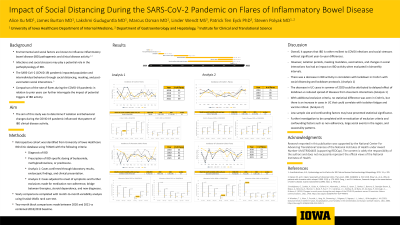Tuesday Poster Session
Category: IBD
P4273 - Impact of Social Distancing During the SARS-CoV-2 Pandemic on Flares of Inflammatory Bowel Disease
Tuesday, October 29, 2024
10:30 AM - 4:00 PM ET
Location: Exhibit Hall E

Has Audio
- AX
Alice Xu, MD
University of Iowa Hospitals & Clinics
Iowa City, IA
Presenting Author(s)
Alice Xu, MD1, James Burton, MD1, Lakshmi Guduguntla, MD2, Marcus Osman, MD1, Linder Wendt, MS1, Patrick Ten Eyck, PhD1, Steven polyak, MD1
1University of Iowa Hospitals & Clinics, Iowa City, IA; 2University of Iowa Health Care, Iowa City, IA
Introduction: Environmental factors are known to influence Inflammatory Bowel Disease (IBD) pathogenesis and clinical disease activity. The SARS-CoV-2 (COVID19) pandemic created a social experiment of enormous magnitude affecting population and interindividual behaviors through social distancing, masking, and post-vaccination let down. The potential role of infections and aeroallergens in the pathophysiology of IBD suggest that broad social distancing measures could influence IBD clinical disease activity. The aim of this study was to determine if isolation behavioral changes during the COVID19 pandemic influenced the pattern of IBD clinical disease activity.
Methods: A retrospective cohort was identified from the IBD database of collected clinical data between 2018 and 2022 through the EPIC electronic medical record at this academic hospital. IBD clinical disease activity was measured by unique prescriptions of prednisone, budesonide, and methylprednisolone associated specifically with a flare of Crohn’s disease and ulcerative colitis. IBD clinical disease activity was evaluated by 3-month intervals that correlated with national and state isolation mandate time periods in 2020 and 2021 and compared to pre-pandemic years in 2018 and 2019.
Results: 319 cases were identified for UC flares and 523 cases were identified for Crohn’s flares. In UC, there was no difference in flares during 2020 isolation with increased flare activity in the 2021 isolation period compared to 2018 and 2019(74, 97, 67, 81; p=0.17). In Crohn’s disease there was decreased flare activity during 2020 and 2021 isolation periods compared to 2018 and 2019(119,104,159,141; p=0.01). Comparison of the total number of cases in 2020-2021 vs 2018-2019 also demonstrated significantly decreased Crohn’s disease activity(394,448; p< .0.001).
Discussion: Interestingly, there was a decrease in Crohn’s disease clinical disease activity and an increase in ulcerative colitis clinical disease activity during the years of the COVID pandemic and specifically during periods of mandated social distancing in 2020-2021 in Iowa. The reasons for this are multifactorial but could include increased stress and decreased pathogen exposure. It has been demonstrated that staying indoors and wearing masks in public reduced viral infections, which then increased after lockdown measures ended. This massive populational experiment during the COVID19 pandemic suggests further support for the role of environmental triggers affecting IBD clinical disease activity.
Disclosures:
Alice Xu, MD1, James Burton, MD1, Lakshmi Guduguntla, MD2, Marcus Osman, MD1, Linder Wendt, MS1, Patrick Ten Eyck, PhD1, Steven polyak, MD1. P4273 - Impact of Social Distancing During the SARS-CoV-2 Pandemic on Flares of Inflammatory Bowel Disease, ACG 2024 Annual Scientific Meeting Abstracts. Philadelphia, PA: American College of Gastroenterology.
1University of Iowa Hospitals & Clinics, Iowa City, IA; 2University of Iowa Health Care, Iowa City, IA
Introduction: Environmental factors are known to influence Inflammatory Bowel Disease (IBD) pathogenesis and clinical disease activity. The SARS-CoV-2 (COVID19) pandemic created a social experiment of enormous magnitude affecting population and interindividual behaviors through social distancing, masking, and post-vaccination let down. The potential role of infections and aeroallergens in the pathophysiology of IBD suggest that broad social distancing measures could influence IBD clinical disease activity. The aim of this study was to determine if isolation behavioral changes during the COVID19 pandemic influenced the pattern of IBD clinical disease activity.
Methods: A retrospective cohort was identified from the IBD database of collected clinical data between 2018 and 2022 through the EPIC electronic medical record at this academic hospital. IBD clinical disease activity was measured by unique prescriptions of prednisone, budesonide, and methylprednisolone associated specifically with a flare of Crohn’s disease and ulcerative colitis. IBD clinical disease activity was evaluated by 3-month intervals that correlated with national and state isolation mandate time periods in 2020 and 2021 and compared to pre-pandemic years in 2018 and 2019.
Results: 319 cases were identified for UC flares and 523 cases were identified for Crohn’s flares. In UC, there was no difference in flares during 2020 isolation with increased flare activity in the 2021 isolation period compared to 2018 and 2019(74, 97, 67, 81; p=0.17). In Crohn’s disease there was decreased flare activity during 2020 and 2021 isolation periods compared to 2018 and 2019(119,104,159,141; p=0.01). Comparison of the total number of cases in 2020-2021 vs 2018-2019 also demonstrated significantly decreased Crohn’s disease activity(394,448; p< .0.001).
Discussion: Interestingly, there was a decrease in Crohn’s disease clinical disease activity and an increase in ulcerative colitis clinical disease activity during the years of the COVID pandemic and specifically during periods of mandated social distancing in 2020-2021 in Iowa. The reasons for this are multifactorial but could include increased stress and decreased pathogen exposure. It has been demonstrated that staying indoors and wearing masks in public reduced viral infections, which then increased after lockdown measures ended. This massive populational experiment during the COVID19 pandemic suggests further support for the role of environmental triggers affecting IBD clinical disease activity.
Disclosures:
Alice Xu indicated no relevant financial relationships.
James Burton indicated no relevant financial relationships.
Lakshmi Guduguntla indicated no relevant financial relationships.
Marcus Osman indicated no relevant financial relationships.
Linder Wendt indicated no relevant financial relationships.
Patrick Ten Eyck indicated no relevant financial relationships.
Steven polyak indicated no relevant financial relationships.
Alice Xu, MD1, James Burton, MD1, Lakshmi Guduguntla, MD2, Marcus Osman, MD1, Linder Wendt, MS1, Patrick Ten Eyck, PhD1, Steven polyak, MD1. P4273 - Impact of Social Distancing During the SARS-CoV-2 Pandemic on Flares of Inflammatory Bowel Disease, ACG 2024 Annual Scientific Meeting Abstracts. Philadelphia, PA: American College of Gastroenterology.
